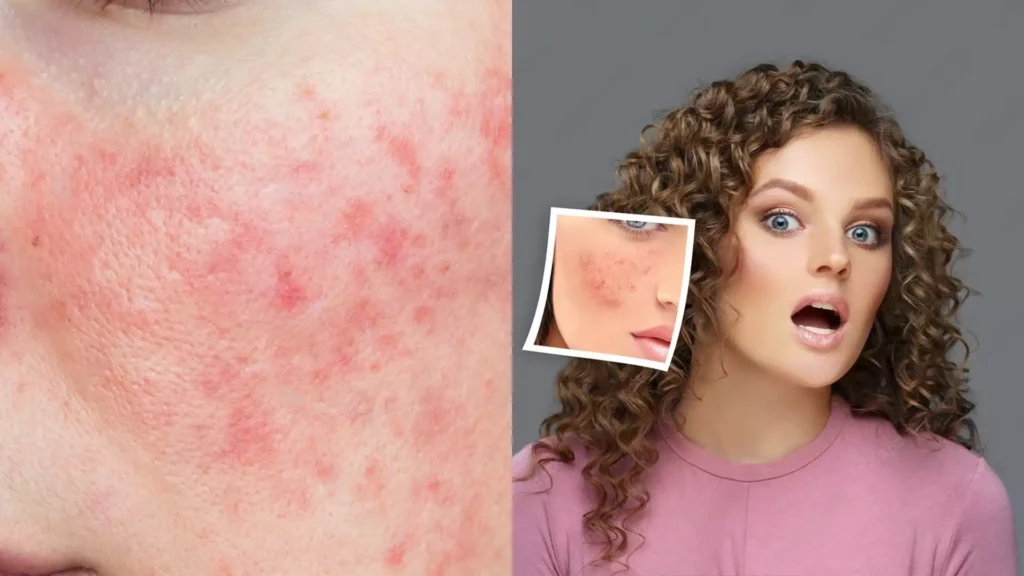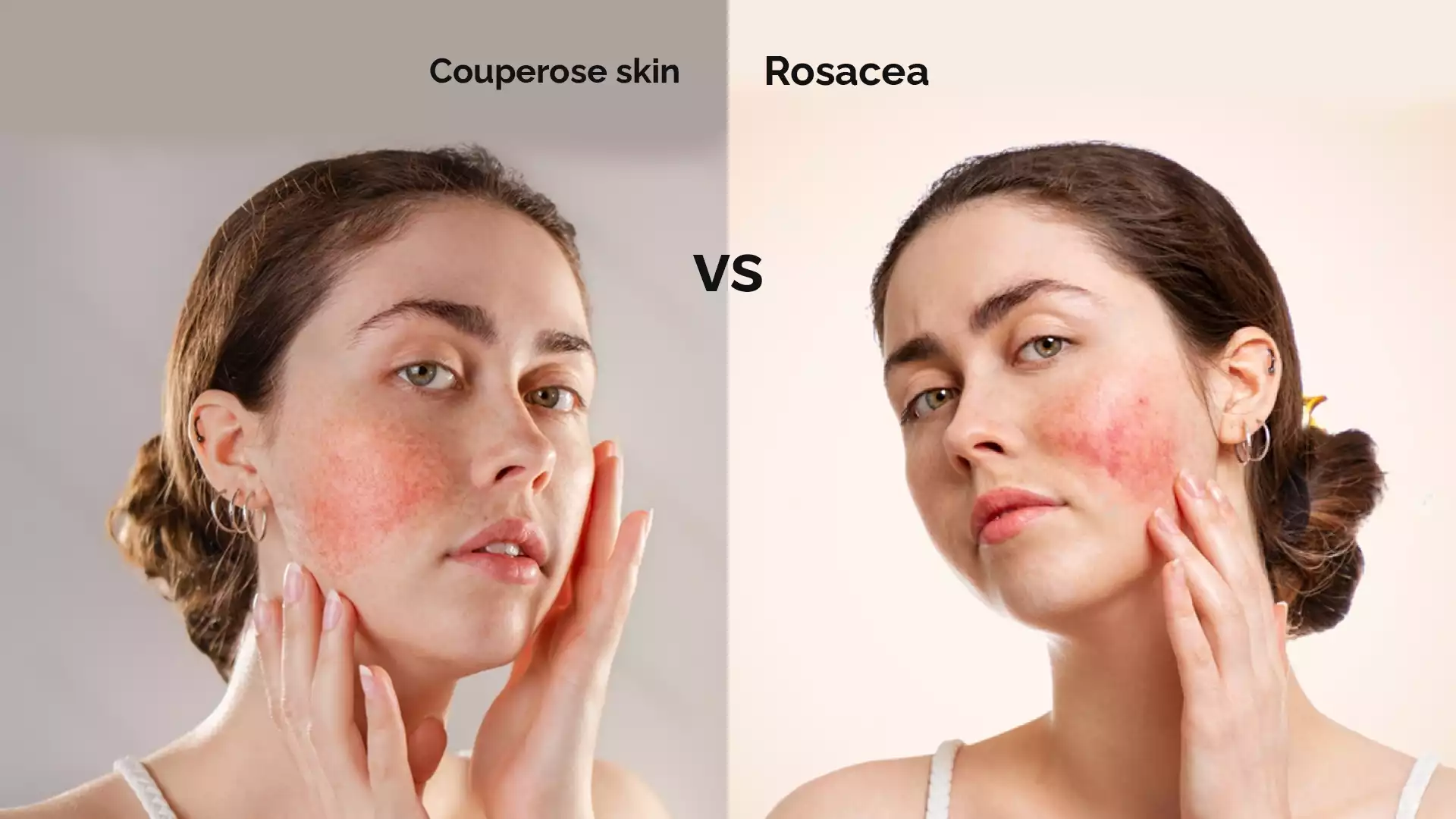When it comes to skin conditions, it’s important to understand the differences between similar-looking conditions to effectively manage and treat them. Two conditions that often cause confusion are couperose skin vs rosacea. Both can manifest as redness on the face, but they have different underlying causes and require different approaches to skincare.
In this blog post, Easy Peasy Skincare will delve into the characteristics, causes, and treatment options for couperose skin vs rosacea, helping you distinguish between the two and make informed decisions about your skincare routine.
Key Concerns of this Blog,
- Understand both conditions
- Differentiating Couperose Skin from Rosacea
- Causes and Treatment for Couperose Skin
- Causes and Treatment for Rosacea
- Final Thoughts
Without any further ado. Let’s get aware of this!
Understand Both Conditions | Couperose Skin vs Rosacea

Couperose skin and Rosacea are the enigmas that can impact one’s complexion and self-confidence.
Couperose skin, often referred to as telangiectasia, showcases delicate networks of dilated blood vessels, creating a tapestry of red or pink patches across the face, predominantly on the cheeks, nose, and chin. This condition is often intertwined with fair or sensitive skin types, and its intensity can escalate with age, presenting challenges that demand attention.
In the guide of couperose skin Vs rosacea on the other hand, we have rosacea skin, a complex and elusive skin disorder characterized by persistent facial redness, bumps, and visible blood vessels. It tends to affect the central areas of the face, including the cheeks, forehead, and nose. Individuals with rosacea may experience flare-ups triggered by various factors such as heat, stress, spicy foods, or alcohol consumption.
Both couperose skin vs rosacea skin can disrupt the natural harmony of our complexion, impacting our daily lives and self-esteem. Yet, each condition possesses its unique characteristics, making them fascinating subjects to explore.
DO YOU KNOW?
The scientific term for couperose skin is termed as “rosacea”
Differentiating Couperose Skin From Rosacea

While in couperose skin Vs rosacea, they may share some similarities, it’s crucial to recognize the distinct characteristics that set them apart. Understanding these differences can help you identify your specific condition and seek appropriate treatment. Let’s explore the key factors that differentiate couperose skin from rosacea:
Appearance:
Couperose skin is indicated by the presence of red or pink patches caused by dilated blood vessels. These patches are often more noticeable on the cheeks, nose, and chin. On the other hand, rosacea involves persistent facial redness that may extend beyond the central areas. In addition to redness, rosacea can lead to the formation of small bumps or pustules, giving the skin a textured appearance.
Affected Areas:
Couperose skin typically appears on specific regions of the face, such as the cheeks, nose, and chin. In contrast, rosacea often affects the central areas, including the cheeks, forehead, nose, and sometimes the chin. The distribution of symptoms can help differentiate between the two conditions.
Triggers:
Identifying the triggers that worsen your symptoms can also aid in distinguishing between couperose skin and rosacea. Couperose skin may worsen due to external factors like sun exposure, extreme temperatures, spicy foods, alcohol, or certain skincare products. In contrast, rosacea flare-ups can be triggered by a broader range of factors, including heat, stress, certain foods, alcohol, caffeine, and even emotional factors.
Additional Symptoms:
While couperose skin mainly presents as visible dilated blood vessels and red patches, rosacea can involve additional symptoms. These may include persistent facial flushing or blushing, stinging or burning sensations, and the development of small, pus-filled bumps or acne-like lesions.
Need to Know!
It’s important to note that couperose skin Vs rosacea skin can coexist or overlap in some cases, making diagnosis and treatment more challenging. Therefore, consulting with a dermatologist or healthcare professional is essential for an accurate evaluation and tailored treatment plan.
Take Note!
By understanding the distinctions between couperose skin Vs rosacea, you can better navigate your skincare journey. Proper identification of your specific condition will lead to more effective management and targeted care, helping you achieve a healthier and more balanced complexion.
Causes and Treatment for Couperose Skin
Causes of Couperose Skin:
- Genetic Predisposition
- Weak Blood Vessel Walls
- Sun Exposure
- Extreme Temperatures
- Lifestyle Factors
Treatment for Couperose Skin:
- Skincare Routine
- Sun Protection
- Temperature Control
- Gentle Cleansing
- Avoiding Triggers
- Medical Treatments (e.g., laser therapy, IPL, electrocautery)
By following these prescribed options you can get your answer on how to get rid of couperose skin. REMEMBER! Patience and Persistence are the key drivers to ultimate success.
Causes and Treatment for Rosacea

Causes of Rosacea:
- Genetic Predisposition
- Abnormal Blood Vessel Function
- Inflammation
- Triggers (sunlight, extreme temperatures, certain foods, alcohol, stress, certain skincare products)
Treatment for Rosacea | Rosacea medication
- Topical Antibiotics: Medications like metronidazole, azelaic acid, or clindamycin are applied directly to the skin to reduce inflammation and control bacterial growth, helping alleviate rosacea symptoms.
- Oral Antibiotics: For moderate to severe cases, dermatologists may prescribe oral antibiotics such as doxycycline, minocycline, or tetracycline. These medications help combat inflammation and effectively manage rosacea symptoms.
- Topical Retinoids: Retinoids, such as tretinoin or adapalene, can be prescribed to improve the overall appearance of the skin and reduce inflammation associated with rosacea.
- Topical Steroids: In certain instances, short-term use of low-potency topical steroids may be recommended to address flare-ups and alleviate redness and inflammation caused by rosacea.
- Alpha Agonists: Topical medications containing alpha agonists like brimonidine work by temporarily constricting blood vessels, reducing redness and providing relief from rosacea-related symptoms.
IMPORTANT!
It is important to note that the selection of medication and its usage should be determined by a qualified healthcare professional, such as a dermatologist, who can assess the individual’s specific condition and tailor the treatment plan accordingly.
Final Thoughts:
While couperose skin vs rosacea both involve facial redness, it’s important to recognize their distinctions. Couperose skin primarily involves dilated blood vessels, often associated with fair or sensitive skin.
Rosacea, on the other hand, presents as persistent redness, visible blood vessels, and occasional acne-like breakouts. Understanding the causes and triggers of each condition is crucial for developing an effective skincare routine and seeking appropriate treatments.
By working with a dermatologist and adopting gentle skincare practices, individuals with couperose skin Vs rosacea skin can manage their symptoms, reduce redness, and maintain healthy, balanced skin.

